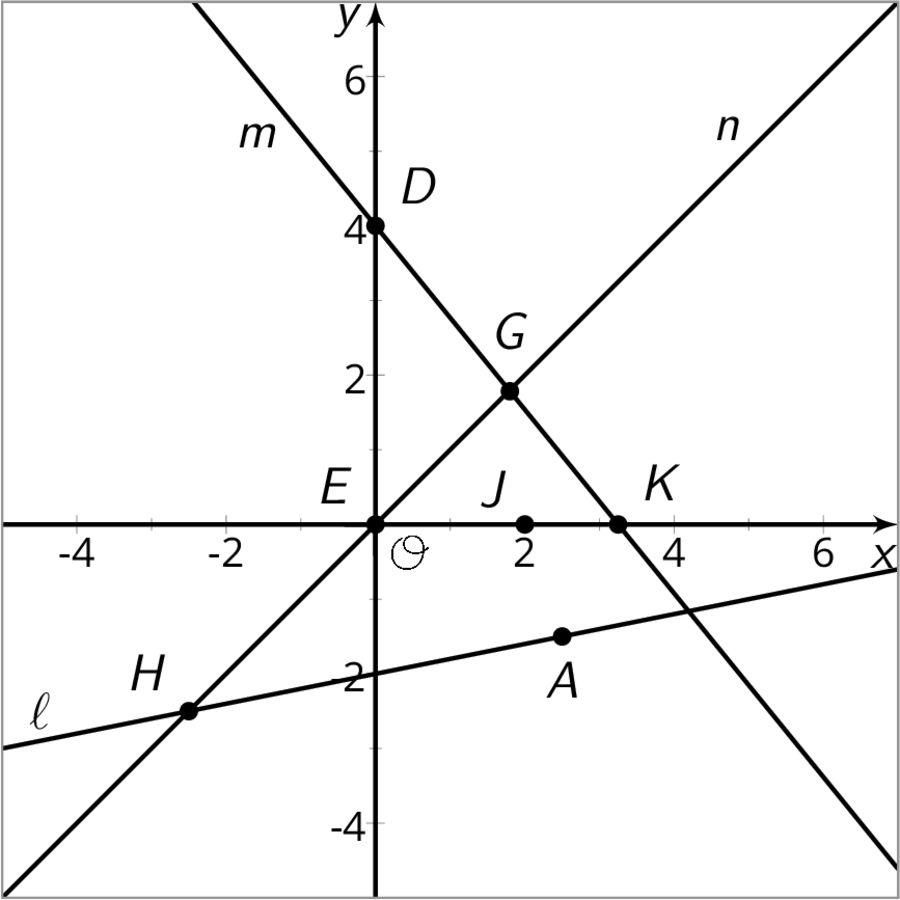13.1: Coordinate Pairs
For each equation choose a value for $x$ and then solve to find the corresponding $y$ value that makes that equation true.
- $6x=7y$
- $5x+3y=9$
- $y+5-\frac13 x=7$
Let’s find solutions to more linear equations.
For each equation choose a value for $x$ and then solve to find the corresponding $y$ value that makes that equation true.
Here are graphs representing three linear relationships. These relationships could also be represented with equations.

For each statement below, decide if it is true or false. Explain your reasoning.
$(4,0)$ is a solution of the equation for line $m$.
The coordinates of the point $G$ make both the equation for line $m$ and the equation for line $n$ true.
$x = 0$ is a solution of the equation for line $n$.
$(2,0)$ makes both the equation for line $m$ and the equation for line $n$ true.
There is no solution for the equation for line $\ell$ that has $y = 0$.
The coordinates of point $H$ are solutions to the equation for line $\ell$.
There are exactly two solutions of the equation for line $\ell$.
There is a point whose coordinates make the equations of all three lines true.
After you finish discussing the eight statements, find another group and check your answers against theirs. Discuss any disagreements.
One partner has 6 cards labeled A through F and one partner has 6 cards labeled a through f. In each pair of cards (for example, Cards A and a), there is an equation on one card and a coordinate pair, $(x,y)$, that makes the equation true on the other card.
The partner with the equation asks the partner with a solution for either the $x$-value or the $y$-value and explains why they chose the one they did.
The partner with the equation uses this value to find the other value, explaining each step as they go.
The partner with the coordinate pair then tells the partner with the equation if they are right or wrong. If they are wrong, both partners should look through the steps to find and correct any errors. If they are right, both partners move onto the next set of cards.
Keep playing until you have finished Cards A through F.
Consider the equation $ax + by = c$, where $a, b,$ and $c$ are positive numbers.
Let's think about the linear equation $2x-4y=12$. If we know $(0,\text-3)$ is a solution to the equation, then we also know $(0,\text-3)$ is a point on the graph of the equation. Since this point is on the $y$-axis, we also know that it is the vertical intercept of the graph. But what about the coordinate of the horizontal intercept, when $y=0$? Well, we can use the equation to figure it out.
\(\begin{align}2x-4y&=12 \\2x-4(0)&=12 \\2x&=12\\x&=6 \end{align}\)
Since $x=6$ when $y=0$, we know the point $(6,0)$ is on the graph of the line. No matter the form a linear equation comes in, we can always find solutions to the equation by starting with one value and then solving for the other value.